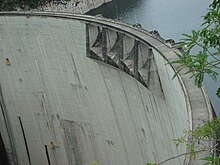El Cajón Dam (Honduras)
| El Cajón Dam | |
|---|---|
 |
|
|
Location of El Cajón Dam in Honduras
|
|
| Official name | Central Hidroeléctrica Francisco Morazán |
| Location | Cortés, Honduras |
| Coordinates | 15°04′47″N 87°33′32″W / 15.07972°N 87.55889°WCoordinates: 15°04′47″N 87°33′32″W / 15.07972°N 87.55889°W |
| Construction began | 1980 |
| Opening date | 1985 |
| Construction cost | US$775 million |
| Operator(s) | ENEE |
| Dam and spillways | |
| Impounds | Comayagua River |
| Height | 226 m (741 ft) |
| Length | 282 m (925 ft) |
| Width (base) | 48 m (157 ft) |
| Reservoir | |
| Total capacity | 5,700,000,000 m3 (2.0×1011 cu ft) |
| Surface area | 94 km2 (36 sq mi) |
| Power station | |
| Commission date | 1986 |
| Turbines | 4 × 75 MW Francis-type |
| Installed capacity | 300 MW |
| El Cajón Dam bridge | |
|---|---|
| Characteristics | |
| Width | 7 m (23 ft) |
The El Cajón Dam, officially known as Central Hidroeléctrica Francisco Morazán, is a hydroelectric power plant located in Western Honduras. The dam impounds the Comayagua River, which derives its large volume from two large tributaries, the Humuya River and the Sulaco River. El Cajón is a double arch dam, which uses parabolic geometry in horizontal and vertical axises to spread the weight of the impounded water to canyon walls which act as buttresses. Overall, the dam is the fifth highest dam in the Americas and the 16th highest in the world, as well as the highest arch dam in the western hemisphere, and the sixth highest worldwide.
El Cajón Dam is located 180 km (112 mi) from Tegucigalpa, the country's capital, and 80 km (50 mi) from San Pedro Sula, the main Honduran industrial city.
Harza Engineering of Chicago, Illinois, United States, began site investigation in the 1960s with initial construction beginning June 15, 1980. A multinational team of designers, builders and engineers included members from Italy, Germany, and Switzerland. Engineering design was developed by Motor Columbus [now Colenco] of Switzerland. Italian companies were responsible for the construction of the underground machine room, while Italian and German companies were responsible for dam construction and ancillary works. Upon completion the dam became the largest piece of infrastructure in Honduras, requiring over half a million cubic meters of concrete to construct. Due to its double-curved arch design, this dam is relatively thin compared to say, Hoover Dam (gravity dam design) that spans a similar valley profile yet required roughly four times as much concrete.
Finite element design was used for the structural components of the dam. The dam is 282 metres long, and 48 meters thick at bottom. The top is 7 meters thick which is wide enough for the small service road that crosses the dam. Around 170 meters from the base of the dam, three 14.5m2 discharge tubes expel water that has passed through the machine room's turbines. Near the top of the dam is a spillway composed of four large square tubes each 14 metres wide that are opened when flow through the dam cannot be handled by the lower discharge tubes.
...
Wikipedia

